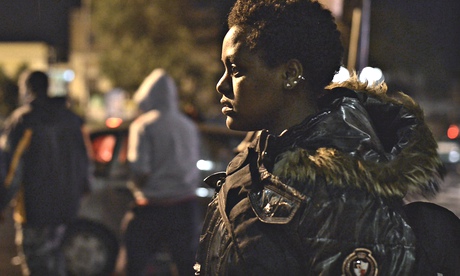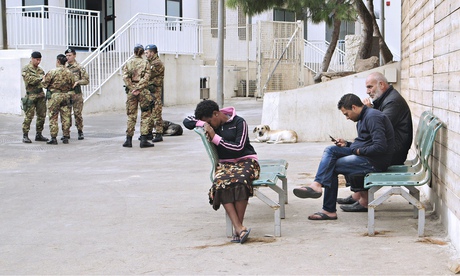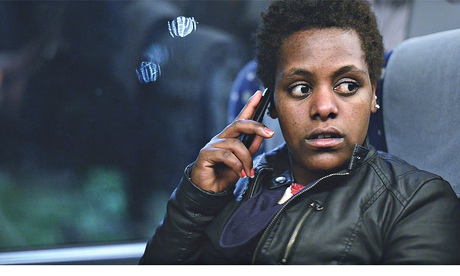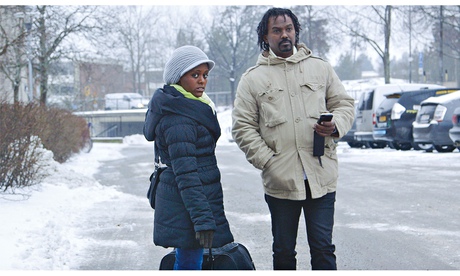Lampedusa boat tragedy: a survivor's story

At 2am on 3 October last year, an overcrowded fishing boat drifted less than half a mile off the Italian island of Lampedusa. For the 518 people packed on board, the twinkling lights of the island signified the end of a long and difficult journey. Each had paid $1,600 (£964) to make the crossing.
With land in sight, they stirred and began excitedly to prepare for their arrival in Europe, dressing in their best clothes and gathering their few possessions in plastic bags. After 36 hours of clattering diesel engine, there was silence. The only sound was the slap of waves against the old wooden hull. The captains of migrant vessels such as this often cut the engines within sight of land and wait for the Italian coastguard to tow them in. This allows the crew to disappear into the crowd and avoid arrest for people-smuggling.
On the upper deck, exposed to the cool night air, people wrapped themselves in blankets. Some smoked and gazed at the distant lights, imagining a new life in Europe. Below deck it was overcrowded and hot, with too many seasick passengers crammed into the confined space.
One of them was 18-year-old Fanus, travelling with her best friend Kisanet. Like almost every other passenger, they had left Eritrea, fleeing the military dictatorship and forced conscription. Fanus had paid smugglers to get her over the border and on through the Sahara to Libya; this Mediterranean crossing was the final leg of a dangerous, expensive journey in search of asylum in Europe. She felt claustrophobic and sick, so she made her way to the top deck to sleep.
Now drifting with the engine off, the boat's bilge pump was no longer active and sea water began to pour in. Alerted by worried passengers, the captain left his small wheelhouse on the top deck and climbed down to the engine bay, stepping over the huddled shapes of people sleeping. According to witnesses, he became agitated at the sight of the leak, tried unsuccessfully to restart the engine, and then poured petrol on to a blanket and set it on fire: he appeared to be trying to attract attention from the shore, or to bring fishing boats to their aid. But the fire burnt his hand, making him drop the blanket. Petrol had spilled on the deck and instantly ignited. Flames shot into the air.
Disturbed by the commotion, the passengers woke to the sight of fire. As they scrambled for safety, people stampeded to one side of the overloaded vessel, which listed and began to capsize in a terrible, slow roll. Those below deck stood no chance. Those on top were thrown into the sea, or tried to cling on as the boat went over.
Selomun, a 24-year-old Eritrean musician, was asleep on the top deck. For most of the journey he had been looking after a four-year-old boy whose mother was sick. "I was woken by people screaming. I had three or four seconds to react as the boat capsized." He grabbed the handrail. "Most people slipped and fell in, but I held on. As the boat tipped to one side, I made my way to the top by moving through the rails like monkey bars."
Fanus woke as the boat lurched and, before she could react, she rolled into the water in the darkness. She couldn't swim, and everyone around her was panicking, struggling to stay afloat: "A guy had me by the neck and was dragging me under, but I pushed him down and was able to shoot myself up to the surface." Another passenger finally pulled her on to the upturned boat.
Selomun was clinging to an iron railing. People were holding on to him, trying to pull themselves up by his belt, but only succeeded in dragging him into the water. His belt broke and they fell back. "They drowned with my trousers in their hands."
As the boat went down, Fanus struggled to escape from the chaos of people thrashing around in the water, holding on to floating corpses. "I'd never been in a body of water before. I was trying to stay afloat by splashing my hands like a dog."
Three hours later, at around 6am, a group of friends returning from a fishing trip on a small private boat heard a noise that sounded like distant seagulls. Through the early morning light they saw arms in the distance, moving in the air, waving. As they got closer, they realised that all around their boat there were 150 to 180 people in the water. The horrible thought dawned that they could not save all these people.

Fanus paid smugglers to help her flee the military dictatorship and forced conscription in Eritrea. Photograph: Zed Nelson
Within 30 minutes, a larger fishing boat had joined the rescue. The crew tried pulling the exhausted survivors aboard, but they were naked and their arms and legs covered in slippery diesel.
By the time the coastguard arrived, Fanus had been in the water for four hours: "They were the longest hours of my life. The rescuers spotted my hands splashing the water, but my head was almost under." A coastguard rescue swimmer dived in and saved her.
Fanus and the other survivors were taken to Lampedusa's small hospital. Of the 80 women on board the migrant boat, only five made it out alive. No children under the age of 12 survived. A local diver raced to the scene of the wreck, but there was no one left alive. He dived to the sunken boat. "I remember some of the bodies very clearly. Two were locked in an embrace, as if they were leaving this life together. The last thing they did was hug each other."
With 366 dead in the sea, the tiny island was overwhelmed by the task of retrieval. The bodies were photographed for identification and transported more than 100 miles away, to be buried in cemeteries around Sicily. As the story became international news, grieving relatives began to arrive from the Eritrean diaspora across Europe.
Two weeks after the tragedy, a state funeral was held in Sicily. Members of the Eritrean government were invited – representatives of the very regime the boat's occupants had been fleeing – but the survivors were denied permission to attend. Many had lost family and friends, and their exclusion sparked an anguished protest in the overcrowded immigration centre on Lampedusa.
Meron Estefanos, an Eritrean activist who lives in Sweden, had arrived in Lampedusa to support the survivors. "It made me angry. If there is anyone who needs closure it's them, and they were denied that." Estefanos works with refugees from one of Africa's most repressive regimes, and describes an exodus of young people: "They tell you, 'Our life is like playing cards. When you are gambling and you have one last card, you don't just quit. There's a 50% chance you might make it, 50% you might die.'" According to Amnesty International, there are 10,000 political prisoners in Eritrean jails; all young people are conscripted into the army at the age of 17, and military service continues indefinitely. In 2013, 14,753 migrants landed on the Sicilian island of Lampedusa. Of these, 9,834 were from Eritrea.

To reach the North African coast, Fanus had used a people-smuggling route fraught with danger. She had been arrested when attempting to flee the country before; this time, she got across the border, but was kidnapped while crossing the Sahara on the way to Libya. "They abducted us and kept us at the foot of a sand dune for 20 days. The boys were tied up by their feet and the kidnappers beat their soles with some kind of rubber stick. They demanded sexual favours from the girls, and if we refused, they would douse us with petrol."
While torturing their captives, the kidnappers forced them to call their relatives and beg for help. Fanus said: "My parents sold everything they had to raise the money – $3,400 [£2,049]. That's how I paid my way out."
After the boat sank, Fanus was held with the other survivors in a newly constructed immigration centre on Lampedusa (it was built to accommodate 800 people, and is already hugely overcrowded). She was suffering from post-traumatic stress and having recurring nightmares. One day, she saw one of the men she says abducted her in the Sahara; he was being brought into the camp with a group of migrants from another boat. When she saw him, she screamed. The camp authorities asked her for an account of what this man had done; he was arrested and flown to Sicily to await trial for kidnap, rape and conspiracy to commit people-smuggling.
Most of the survivors were moved from Lampedusa to temporary accommodation in Rome, but Fanus and five other witnesses were held on the island until called to give evidence against the alleged kidnapper.
Like many of the survivors, Fanus dreamed of starting a new life in Europe, and had set her sights on Sweden. Italy has high unemployment and poor social security, limited training and education opportunities for refugees, and a system that's hard to navigate even for Italians; asylum seekers in Italy have protested about ill-treatment and racism.

After being moved to an immigration centre in Sicily, Fanus escaped and boarded a bus to Rome. Photograph: Zed Nelson
To achieve her aim, Fanus knew she must avoid being registered as an asylum seeker in Italy (under the EU's "Dublin" regulation, refugees must claim asylum in the first European country they enter). If the Italian authorities took her fingerprints, and she subsequently tried to claim asylum elsewhere, she would be sent back to Italy. Trapped on Lampedusa, Fanus tried to burn and disfigure her fingerprints. With a lighter she burned a plastic bag, then set the melted, boiling plastic against her fingertips.
In mid-January, three and a half months after the boat wreck, Fanus was finally moved off the island. She and the other five survivors were taken to Palermo to testify against the alleged kidnapper and allowed to give evidence ahead of the trial, which isn't due to take place for months.
Afterwards, Fanus was escorted from the court by police and driven to a crowded immigration centre in Pozzallo, on the other side of Sicily. Here, asylum seekers and migrants from Africa sleep in rows on mattresses on the floor, in a huge open building like an aircraft hangar. Overnight, Fanus and the others made a break for freedom, climbing a high fence to escape. After a bus ride to the nearest town, a relative of a survivor met them at a coach terminal and gave them tickets to Rome.
At the end of the 15-hour bus journey, they were met by a man who took them to an abandoned tenement block on the outskirts, populated mainly by migrants paying for the services of people smugglers. There, Fanus was told that to get to Stockholm she must pay $850 (£512) for a fake passport and an airline ticket. She would have to wait for her family in Eritrea to send more money.

Fanus with an Eritrean friend in Sweden. Photograph: Zed Nelson
Two weeks later – after taking a train to Milan and a plane to Barcelona – Fanus finally arrived in Stockholm and was staying at Meron Estefanos's apartment. By now, all but two of the 155 survivors of the boat disaster had left Italy; most were seeking asylum in Sweden or Norway, a handful in Germany. "It's freezing here! I wish the sun would come out," Fanus laughed. She had spent the day shopping, painting her nails and visiting McDonald's for the first time. She said she was happy to have fulfilled her dream of arriving in Sweden, and looked forward to sending her first pay cheque to her parents. The thought of her journey from Africa still filled her with horror: "I don't want to look back and remember my journey, nobody should have to go through what we did. I wouldn't wish it on my worst enemy."
The next day, she claimed asylum in Sweden, and is currently waiting for a decision to be made. Many survivors who make it to northern Europe do not tell the authorities the truth about how they got there. "They are afraid if they tell their story, there is a risk they will be sent back to Italy," Estefanos says, "so for that reason people choose not to mention they survived the boat tragedy. They pretend they came a different route." Fanus, however, decided to take her chances. "If they want to send us back to Italy, we'll tell them Italy did not treat us right. We just have to be honest."
There is no way for refugees to seek asylum from EU countries before they travel to Europe. This, Estefanos believes, is part of the problem, because it fuels illicit people-smuggling. "The whole system is a joke. We know over 90% of Eritreans who come and ask for asylum receive asylum. So it is like, 'We'll give you asylum only as long as you manage to overcome the hardship to get here.' But when you know you are going to give them asylum anyway, why let them go through all that?"
As we approach summer, the crossings are starting again and migrants are arriving on Lampedusa. Those who make shore are the luckier ones. The most recent UN figures, for 2011-12, suggest that more than 2,000 people were reported dead or missing at sea as they tried to reach Europe between 2011 and 2012. This year, hundreds more will die in the Mediterranean.
• Fanus's last name has been withheld to protect her family.
Zed Nelson's film about survivors of the Lampedusa boat tragedy will air on Channel 4's Dispatches early next month.


![[AIM] Asmarino Independent Media](/images/logo/ailogo.png)